Effects of Hydrological Season on the Relationship between Land Use and Surface Water Quality
Abstract
:1. Introduction
2. Data and Methods
2.1. Study Area
2.2. Data and Indicators
2.2.1. Land Use
2.2.2. Surface Water Quality
2.3. Method
2.3.1. Hypothesis
- (i)
- The explanatory ability of land uses to the spatial variation of water quality is different in hydrological seasons, and the effect is greater in the wet season because the rainfall runoff effect is more significant, but lower in the dry season.
- (ii)
- Under different scales of hydrological response units, the explanatory ability of land use to the spatial variation of water quality is more complex. The effect should be small at the riparian scale, and the degree of influence can be increased with the enlarged scales.
2.3.2. Application of Hydrological Response Units
2.3.3. Redundancy Analysis (RDA)
3. Results
3.1. Surface Water Quality of Different Hydrological Seasons
3.2. Pearson’s Correlation Analysis
3.2.1. Correlation among Surface Water Quality Indicators
3.2.2. Correlation between Land Use and Water Quality
3.3. RDA on the Relationship
4. Discussions
4.1. Difference of Spatial Effect of Land Uses
4.2. Differences in Various Hydrological Seasons
4.3. Comparison with the Hypothesis
4.4. Limitations
5. Conclusions
Author Contributions
Funding
Data Availability Statement
Conflicts of Interest
References
- Batbayar, G.; Pfeiffer, M.; Kappas, M.; Karthe, D. Development and application of GIS-based assessment of land-use impacts on water quality: A case study of the Kharaa River Basin. AMBIO 2018, 48, 1154–1168. [Google Scholar] [CrossRef]
- Carroll, S.; Liu, A.; Dawes, L.; Hargreaves, M.; Goonetilleke, A. Role of Land Use and Seasonal Factors in Water Quality Degradations. Water Resour. Manag. 2013, 27, 3433–3440. [Google Scholar] [CrossRef] [Green Version]
- Hanna, D.E.L.; Lehner, B.; Taranu, Z.E.; Solomon, C.T.; Bennett, E.M. The relationship between watershed protection and water quality: The case of Québec, Canada. Freshw. Sci. 2021, 40, 382–396. [Google Scholar] [CrossRef]
- Qiu, Z.; Hall, C.; Drewes, D.; Messinger, G.; Prato, T.; Hale, K.; Van Abs, D. Hydrologically Sensitive Areas, Land Use Controls, and Protection of Healthy Watersheds. J. Water Resour. Plan. Manag. 2014, 140, 04014011. [Google Scholar] [CrossRef]
- Wang, L.; Wang, S.; Zhou, Y.; Zhu, J.; Zhang, J.; Hou, Y.; Liu, W. Landscape pattern variation, protection measures, and land use/land cover changes in drinking water source protection areas: A case study in Danjiangkou Reservoir, China. Glob. Ecol. Conserv. 2019, 21, e00827. [Google Scholar] [CrossRef]
- Cheng, P.; Meng, F.; Wang, Y.; Zhang, L.; Yang, Q.; Jiang, M. The Impacts of Land Use Patterns on Water Quality in a Trans-Boundary River Basin in Northeast China Based on Eco-Functional Regionalization. Int. J. Environ. Res. Public Health 2018, 15, 1872. [Google Scholar] [CrossRef] [Green Version]
- Fan, K.; Pei, W.J.; Zhang, J.S.; Yu, J.X.; Zeng, W.J. Analysis on landscape pattern of land use and eco- environment characteristics of three lake basins in yunnan province, china. Appl. Ecol. Environ. Res. 2018, 16, 5693–5704. [Google Scholar] [CrossRef]
- Cui, H.; Zhou, X.; Guo, M.; Wu, W. Land use change and its effects on water quality in typical inland lake of arid area in China. J. Environ. Biol. 2016, 37, 603–609. [Google Scholar]
- Xia, L.L.; Liu, R.Z.; Zao, Y.W. Correlation Analysis of Landscape Pattern and Water Quality in Baiyangdian Watershed. In Proceedings of the 18th Biennial ISEM Conference on Ecological Modelling for Global Change and Coupled Human and Natural Systems, Beijing, China, 20–23 September 2011; Beijing Normal University: Beijing, China, 2011; pp. 2188–2196. [Google Scholar]
- Xu, F.; Bao, H.X.; Li, H.; Kwan, M.-P.; Huang, X. Land use policy and spatiotemporal changes in the water area of an arid region. Land Use Policy 2016, 54, 366–377. [Google Scholar] [CrossRef] [Green Version]
- Bai, X.; Shen, W.; Wang, P.; Chen, X.; He, Y. Response of Non-point Source Pollution Loads to Land Use Change under Different Precipitation Scenarios from a Future Perspective. Water Resour. Manag. 2020, 34, 3987–4002. [Google Scholar] [CrossRef]
- Gong, D.; Hong, X.; Zeng, G.; Wang, Y.; Zuo, S.; Liu, X.; Wu, J. Prediction of Water Quality in Rivers in Agricultural Regions Typical of Subtropics in China Using Multivariate Linear Regression Model. J. Ecol. Rural. Environ. 2017, 33, 509–518. [Google Scholar]
- Pan, Y.; Yu, D.; Wang, X.; Xu, Z.C.; Wang, X.Y. Prediction of Land Use Landscape Pattern Based on CA-Markov Model. Soils 2018, 50, 391–397. [Google Scholar]
- Dunn, S.M.; Sample, J.; Potts, J.; Abel, C.; Cook, Y.; Taylor, C.; Vinten, A.J.A. Recent trends in water quality in an agricultural catchment in Eastern Scotland: Elucidating the roles of hydrology and land use. Environ. Sci. Process. Impacts 2014, 16, 1659–1675. [Google Scholar] [CrossRef]
- Zhang, M.-S.; Li, W.; Zhang, W.-G.; Li, Y.-T.; Li, J.-Y.; Gao, Y. Agricultural land-use change exacerbates the dissemination of antibiotic resistance genes via surface runoffs in Lake Tai Basin, China. Ecotoxicol. Environ. Saf. 2021, 220, 112328. [Google Scholar] [CrossRef] [PubMed]
- Herlihy, A.T.; Stoddard, J.L.; Johnson, C.B. The Relationship between Stream Chemistry and Watershed Land Cover Data in the Mid-Atlantic Region, U.S. Water Air Soil Pollut. 1998, 105, 377–386. [Google Scholar] [CrossRef]
- Galbraith, L.M.; Burns, C.W. Linking Land-use, Water Body Type and Water Quality in Southern New Zealand. Landsc. Ecol. 2006, 22, 231–241. [Google Scholar] [CrossRef]
- Clune, J.W.; Crawford, J.K.; Chappell, W.T.; Boyer, E.W. Differential effects of land use on nutrient concentrations in streams of Pennsylvania. Environ. Res. Commun. 2020, 2, 115003. [Google Scholar] [CrossRef]
- Gorgoglione, A.; Gregorio, J.; Ríos, A.; Alonso, J.; Chreties, C.; Fossati, M. Influence of Land Use/Land Cover on Surface-Water Quality of Santa Lucía River, Uruguay. Sustainability 2020, 12, 4692. [Google Scholar] [CrossRef]
- Chen, D.; Elhadj, A.; Xu, H.; Xu, X.; Qiao, Z. A Study on the Relationship between Land Use Change and Water Quality of the Mitidja Watershed in Algeria Based on GIS and RS. Sustainability 2020, 12, 3510. [Google Scholar] [CrossRef]
- de Mello, K.; Taniwaki, R.H.; de Paula, F.R.; Valente, R.A.; Randhir, T.O.; Macedo, D.R.; Leal, C.G.; Rodrigues, C.B.; Hughes, R.M. Multiscale land use impacts on water quality: Assessment, planning, and future perspectives in Brazil. J. Environ. Manag. 2020, 270, 110879. [Google Scholar] [CrossRef]
- Xu, S.; Li, S.-L.; Zhong, J.; Li, C. Spatial scale effects of the variable relationships between landscape pattern and water quality: Example from an agricultural karst river basin, Southwestern China. Agric. Ecosyst. Environ. 2020, 300, 106999. [Google Scholar] [CrossRef]
- Fang, N.; Liu, L.-L.; You, Q.-H.; Tian, N.; Wu, Y.-P.; Yang, W.-J. Effects of Land Use Types at Different Spatial Scales on Water Quality in Poyang Lake Wetland. Huan Jing Ke Xue=Huanjing Kexue 2019, 40, 5348–5357. [Google Scholar] [PubMed]
- Deng, X. Influence of water body area on water quality in the southern Jiangsu Plain, eastern China. J. Clean. Prod. 2020, 254, 120136. [Google Scholar] [CrossRef]
- Álvarez-Cabria, M.; Barquín, J.; Peñas, F.J. Modelling the spatial and seasonal variability of water quality for entire river networks: Relationships with natural and anthropogenic factors. Sci. Total Environ. 2016, 545–546, 152–162. [Google Scholar] [CrossRef]
- Yu, X.; Hawley-Howard, J.; Pitt, A.L.; Wang, J.-J.; Baldwin, R.F.; Chow, A.T. Water quality of small seasonal wetlands in the Piedmont ecoregion, South Carolina, USA: Effects of land use and hydrological connectivity. Water Res. 2015, 73, 98–108. [Google Scholar] [CrossRef] [PubMed]
- Xu, J.; Liu, R.; Ni, M.; Zhang, J.; Ji, Q.; Xiao, Z. Seasonal variations of water quality response to land use metrics at multi-spatial scales in the Yangtze River basin. Environ. Sci. Pollut. Res. 2021, 28, 37172–37181. [Google Scholar] [CrossRef]
- Li, G.Y.; Li, L.Z.; Kong, M. Multiple-Scale Analysis of Water Quality Variations and Their Correlation with Land use in Highly Urbanized Taihu Basin, China. Bull. Environ. Contam. Toxicol. 2020, 106, 218–224. [Google Scholar] [CrossRef]
- Vogt, R.J.; Frost, P.C.; Nienhuis, S.; Woolnough, D.A.; Xenopoulos, M.A. The dual synchronizing influences of precipitation and land use on stream properties in a rapidly urbanizing watershed. Ecosphere 2016, 7, e01427. [Google Scholar] [CrossRef]
- Wang, J.; Hou, L.; He, X.; Liu, T.; Deng, Y. Land Use Change and Its Eco-environmental Effects in Urban Agglomeration of Chengdu Plain During 2000–2019. Bull. Soil Water Conserv. 2022, 42, 360–368. [Google Scholar]
- Zhao, W.; Zhu, X.; Sun, X.; Shu, Y.; Li, Y. Water quality changes in response to urban expansion: Spatially varying relations and determinants. Environ. Sci. Pollut. Res. 2015, 22, 16997–17011. [Google Scholar] [CrossRef]
- Zhou, X.; Zhang, W.; Pei, Y.; Jiang, X.; Yang, S. Zoning Strategy for Basin Land Use Optimization for Reducing Nitrogen and Phosphorus Pollution in Guizhou Karst Watershed. Water 2022, 14, 2589. [Google Scholar] [CrossRef]
- Wang, J.; Zhang, J.; Xiong, N.; Liang, B.; Wang, Z.; Cressey, E.L. Spatial and Temporal Variation, Simulation and Prediction of Land Use in Ecological Conservation Area of Western Beijing. Remote. Sens. 2022, 14, 1452. [Google Scholar] [CrossRef]
- Wang, Z.; Zhang, S.; Peng, Y.; Wu, C.; Lv, Y.; Xiao, K.; Zhao, J.; Qian, G. Impact of rapid urbanization on the threshold effect in the relationship between impervious surfaces and water quality in shanghai, China. Environ. Pollut. 2020, 267, 115569. [Google Scholar] [CrossRef] [PubMed]
- Zhao, J.; Lin, L.; Yang, K.; Liu, Q.; Qian, G. Influences of land use on water quality in a reticular river network area: A case study in Shanghai, China. Landsc. Urban Plan. 2015, 137, 20–29. [Google Scholar] [CrossRef]
- Dou, J.; Xia, R.; Chen, Y.; Chen, X.; Cheng, B.; Zhang, K.; Yang, C. Mixed spatial scale effects of landscape structure on water quality in the Yellow River. J. Clean. Prod. 2022, 368, 133008. [Google Scholar] [CrossRef]
- Li, S.; Zhang, J.; Jiang, P.; Zhang, L. Linking land use with riverine water quality: A multi-spatial scale analysis relating to various riparian strips. Front. Environ. Sci. 2022, 10, 1013318. [Google Scholar] [CrossRef]
- Wang, N.; Xiong, J.; Wang, X.C.; Zhang, Y.; Liu, H.; Zhou, B.; Pan, P.; Liu, Y.; Ding, F. Relationship between phytoplankton community and environmental factors in landscape water with high salinity in a coastal city of China. Environ. Sci. Pollut. Res. 2018, 25, 28460–28470. [Google Scholar] [CrossRef]
- Neill, C.; Deegan, L.A.; Thomas, S.M.; Cerri, C.C. Deforestation for pasture alters nitrogen and phosphorus in small Amazonian Streams. Ecol. Appl. 2001, 11, 1817–1828. [Google Scholar] [CrossRef]
- Xu, Z.; Xu, J.; Yin, H.; Jin, W.; Li, H.; He, Z. Urban river pollution control in developing countries. Nat. Sustain. 2019, 2, 158–160. [Google Scholar] [CrossRef]
- Yin, H.; Xie, M.; Zhang, L.; Huang, J.; Xu, Z.; Li, H.; Jiang, R.; Wang, R.; Zeng, X. Identification of sewage markers to indicate sources of contamination: Low cost options for misconnected non-stormwater source tracking in stormwater systems. Sci. Total. Environ. 2018, 648, 125–134. [Google Scholar] [CrossRef]
- Shi, Y.; Yao, Y.; Zhao, J.; Li, X.; Yu, J.; Qian, G. Changes in Reticular River Network under Rapid Urbanization: A Case of Pudong New Area, Shanghai. Water 2022, 14, 523. [Google Scholar] [CrossRef]
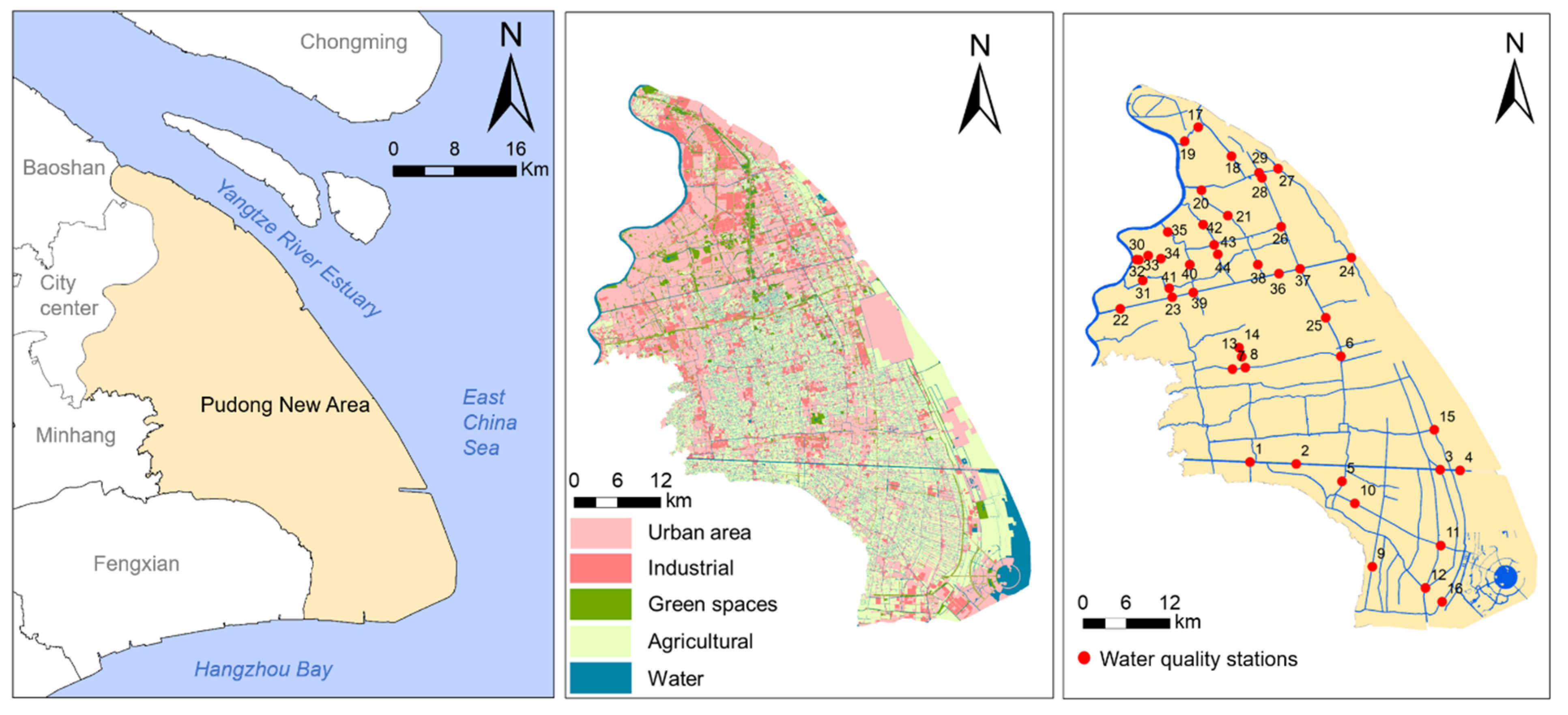
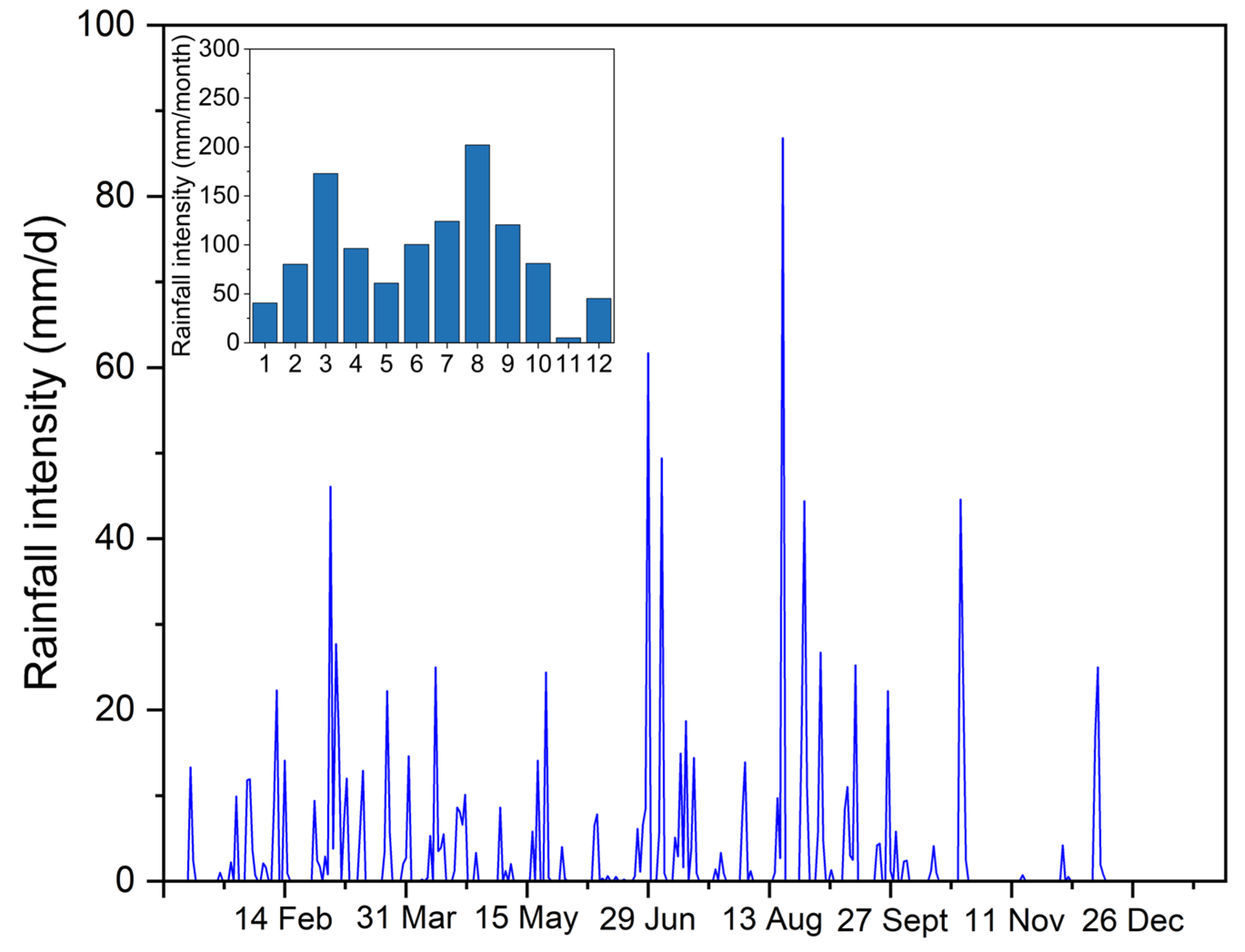
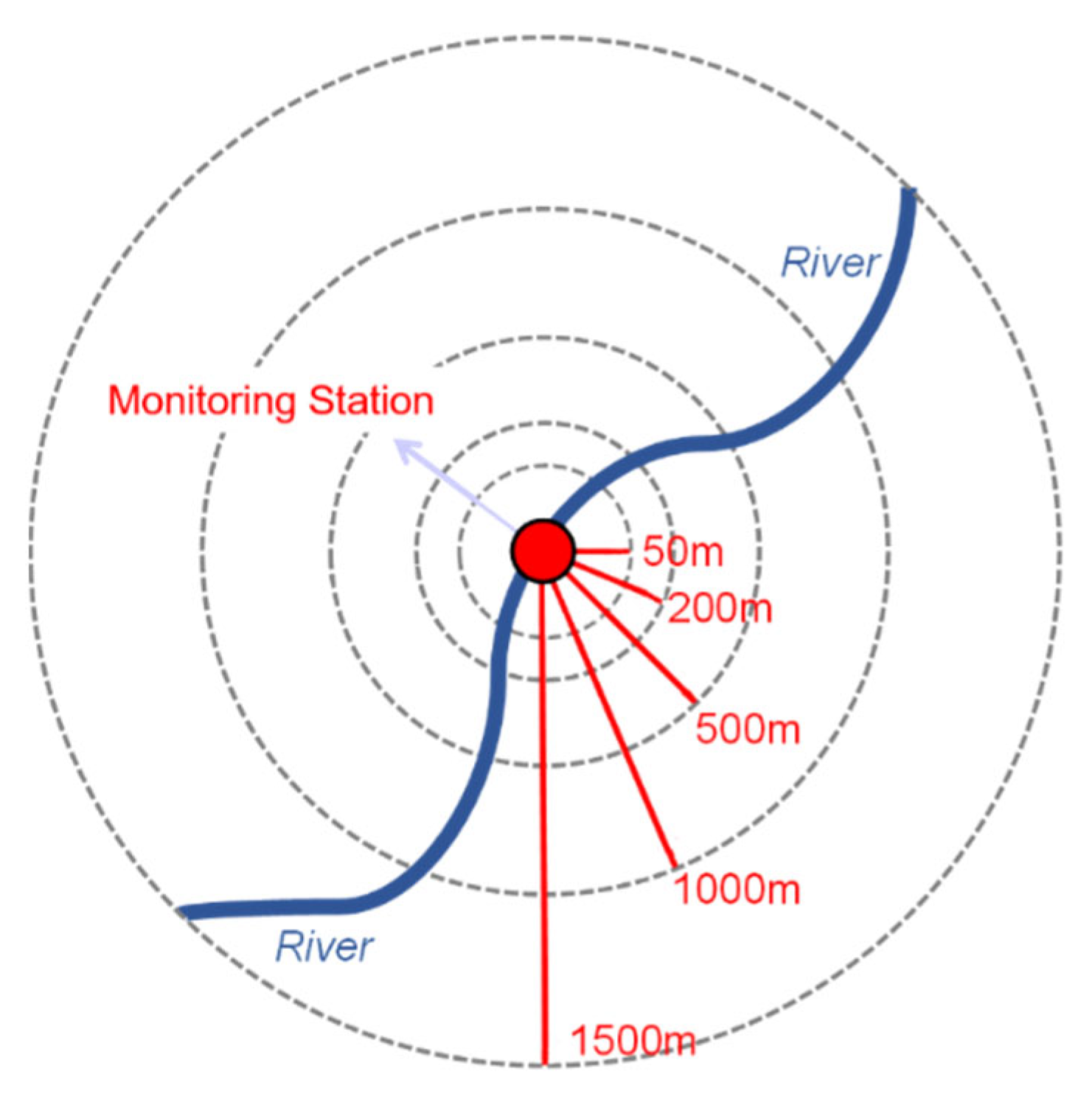

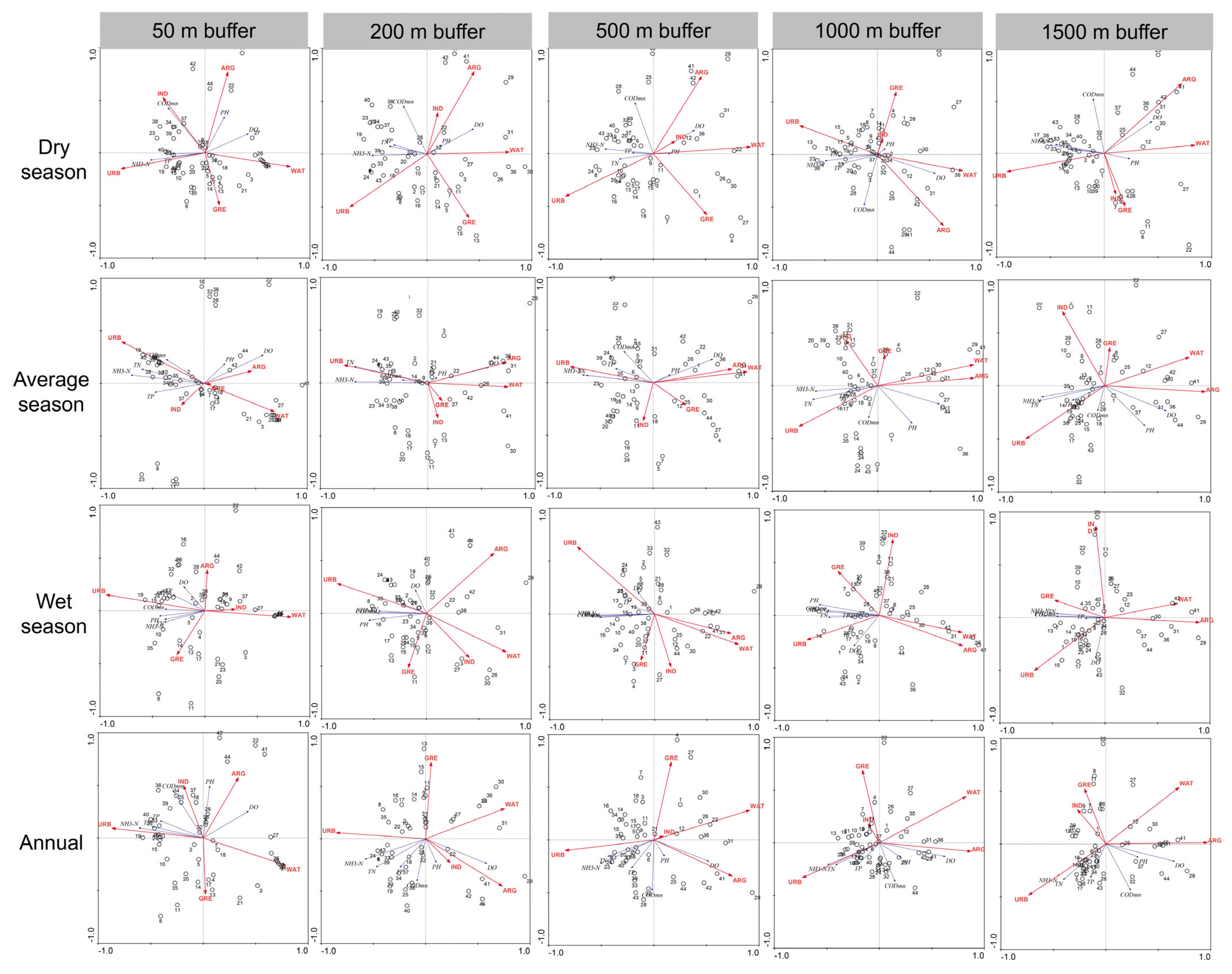
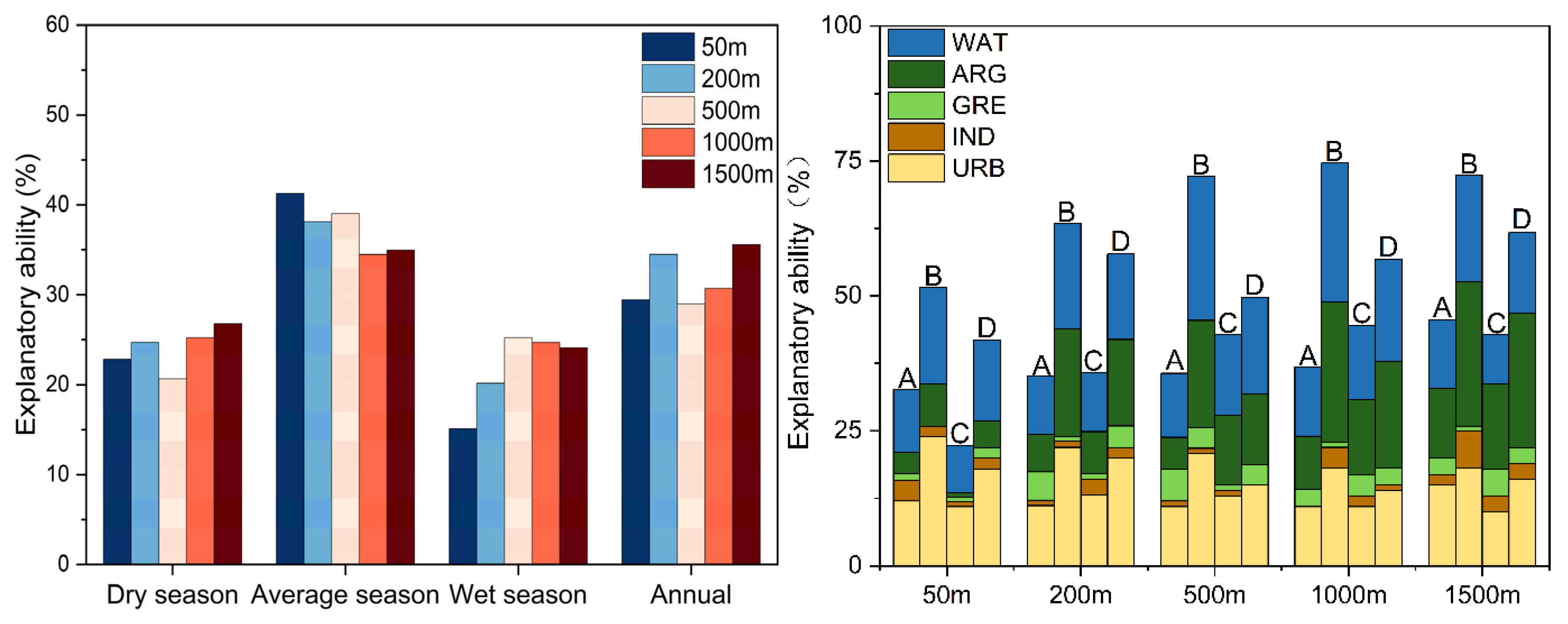
| Hydrological Season | Indicators | pH | DO | CODMn | BOD | NH3-N | TP | TN |
|---|---|---|---|---|---|---|---|---|
| Dry season | pH | 1 | ||||||
| DO | 0.145 | 1 | ||||||
| CODMn | −0.114 | 0.001 | 1 | |||||
| BOD | −0.186 | −0.144 | 0.921 ** | 1 | ||||
| NH3-N | −0.390 ** | −0.383 * | 0.684 ** | 0.783 ** | 1 | |||
| TP | −0.219 | −0.289 | 0.743 ** | 0.856 ** | 0.700 ** | 1 | ||
| TN | −0.297 | −0.261 | 0.773 ** | 0.879 ** | 0.900 ** | 0.836 ** | 1 | |
| Average season | pH | 1 | ||||||
| DO | 0.347 * | 1 | ||||||
| CODMn | 0.101 | −0.123 | 1 | |||||
| BOD | 0.095 | −0.115 | 0.822 ** | 1 | ||||
| NH3-N | −0.200 | −0.520 ** | 0.562 ** | 0.608 ** | 1 | |||
| TP | −0.173 | −0.394 ** | 0.579 ** | 0.558 ** | 0.751 ** | 1 | ||
| TN | −0.140 | −0.418 ** | 0.580 ** | 0.580 ** | 0.839 ** | 0.561 ** | 1 | |
| Wet season | pH | 1 | ||||||
| DO | 0.651 ** | 1 | ||||||
| CODMn | 0.451 ** | 0.261 | 1 | |||||
| BOD | 0.008 | 0.034 | 0.460 ** | 1 | ||||
| NH3-N | −0.305 * | −0.571 ** | 0.303 * | 0.424 ** | 1 | |||
| TP | 0.321 * | 0.145 | 0.750 ** | 0.377 * | 0.373 * | 1 | ||
| TN | −0.074 | −0.315 * | 0.479 ** | 0.510 ** | 0.824 ** | 0.552 ** | 1 | |
| Annual mean | pH | 1 | ||||||
| DO | 0.389 ** | 1 | ||||||
| CODMn | 0.206 | 0.273 | 1 | |||||
| BOD | 0.171 | 0.080 | 0.853 ** | 1 | ||||
| NH3-N | −0.052 | −0.329 * | 0.654 ** | 0.812 ** | 1 | |||
| TP | −0.031 | −0.089 | 0.798 ** | 0.797 ** | 0.799 ** | 1 | ||
| TN | −0.015 | −0.206 | 0.700 ** | 0.858 ** | 0.920 ** | 0.848 ** | 1 |
| Buffer Radius | Indicators | URB | IND | GRE | ARG | WAT |
|---|---|---|---|---|---|---|
| 50 m | pH | 0.075 | 0.173 | −0.004 | 0.630 ** | −0.334 * |
| DO | −0.393 ** | 0.060 | −0.141 | 0.319 * | 0.302 * | |
| CODMn | 0.291 | 0.273 | −0.260 | 0.143 | −0.328 * | |
| BOD | 0.355 * | 0.405 ** | −0.159 | 0.078 | −0.481 ** | |
| NH3−N | 0.486 ** | 0.224 | −0.063 | −0.119 | −0.498 ** | |
| TP | 0.315 * | 0.231 | −0.200 | −0.166 | −0.268 | |
| TN | 0.363 * | 0.219 | −0.115 | −0.127 | −0.356 * | |
| 200 m | pH | −0.119 | −0.035 | 0.002 | 0.418 ** | −0.251 |
| DO | −0.564 ** | 0.209 | −0.152 | 0.593 ** | 0.405 ** | |
| CODMn | 0.053 | 0.071 | −0.340 * | 0.134 | −0.162 | |
| BOD | 0.109 | 0.170 | −0.289 | 0.013 | −0.380 * | |
| NH3−N | 0.386 ** | −0.008 | −0.182 | −0.270 | −0.477 ** | |
| TP | 0.134 | 0.146 | −0.270 | −0.139 | −0.181 | |
| TN | 0.283 | 0.059 | −0.219 | −0.215 | −0.369 * | |
| 500 m | pH | −0.153 | −0.072 | −0.010 | 0.275 | −0.033 |
| DO | −0.454 ** | 0.037 | −0.086 | 0.504 ** | 0.473 ** | |
| CODMn | 0.036 | 0.009 | −0.369 * | 0.180 | −0.169 | |
| BOD | 0.108 | 0.109 | −0.287 | 0.001 | −0.324 * | |
| NH3−N | 0.409 ** | −0.026 | −0.242 | −0.287 | −0.468 ** | |
| TP | 0.141 | 0.130 | −0.242 | −0.099 | −0.259 | |
| TN | 0.344 * | 0.003 | −0.197 | −0.273 | −0.360 * | |
| 1000 m | pH | −0.145 | −0.271 | −0.013 | 0.337 * | 0.147 |
| DO | −0.454 ** | −0.084 | −0.235 | 0.611 ** | 0.509 ** | |
| CODMn | 0.000 | −0.074 | −0.246 | 0.163 | −0.053 | |
| BOD | 0.091 | 0.090 | −0.163 | −0.044 | −0.257 | |
| NH3−N | 0.396 ** | 0.034 | −0.110 | −0.372 * | −0.451 ** | |
| TP | 0.139 | 0.085 | −0.098 | −0.130 | −0.254 | |
| TN | 0.370 * | −0.002 | −0.117 | −0.331 * | −0.387 ** | |
| 1500 m | pH | −0.164 | −0.280 | −0.001 | 0.358 * | 0.166 |
| DO | −0.448 ** | −0.238 | −0.240 | 0.690 ** | 0.405 ** | |
| CODMn | 0.045 | −0.162 | −0.288 | 0.199 | −0.097 | |
| BOD | 0.166 | −0.021 | −0.180 | −0.037 | −0.278 | |
| NH3−N | 0.465 ** | 0.000 | −0.096 | −0.402 ** | −0.455 ** | |
| TP | 0.213 | 0.013 | −0.120 | −0.140 | −0.317 * | |
| TN | 0.443 ** | −0.050 | −0.120 | −0.345 * | −0.402 ** |
Disclaimer/Publisher’s Note: The statements, opinions and data contained in all publications are solely those of the individual author(s) and contributor(s) and not of MDPI and/or the editor(s). MDPI and/or the editor(s) disclaim responsibility for any injury to people or property resulting from any ideas, methods, instructions or products referred to in the content. |
© 2023 by the authors. Licensee MDPI, Basel, Switzerland. This article is an open access article distributed under the terms and conditions of the Creative Commons Attribution (CC BY) license (https://creativecommons.org/licenses/by/4.0/).
Share and Cite
Wang, D.; Huang, G.; Ding, H.; Zhang, X.; Wang, H.; Zhang, Z.; Li, D.; Zhao, J. Effects of Hydrological Season on the Relationship between Land Use and Surface Water Quality. Water 2023, 15, 2351. https://doi.org/10.3390/w15132351
Wang D, Huang G, Ding H, Zhang X, Wang H, Zhang Z, Li D, Zhao J. Effects of Hydrological Season on the Relationship between Land Use and Surface Water Quality. Water. 2023; 15(13):2351. https://doi.org/10.3390/w15132351
Chicago/Turabian StyleWang, Du, Ganping Huang, Huizhi Ding, Xing Zhang, Han Wang, Zhuo Zhang, Dingyi Li, and Jun Zhao. 2023. "Effects of Hydrological Season on the Relationship between Land Use and Surface Water Quality" Water 15, no. 13: 2351. https://doi.org/10.3390/w15132351




